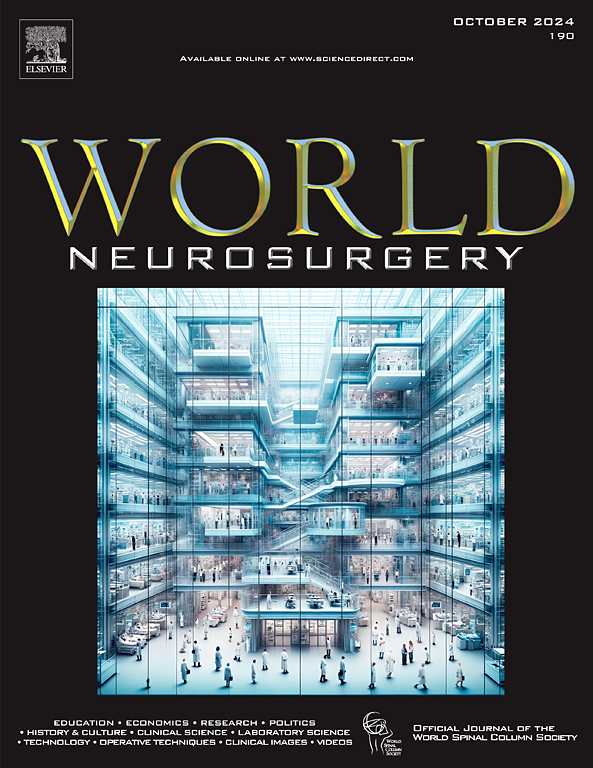An Application of Combined Transpetrosal Approach With Microneurovascular Transposition in Recurrent Trigeminal Neuralgia Caused by Dolichoectatic Vertebral Artery
IF 1.9
4区 医学
Q3 CLINICAL NEUROLOGY
引用次数: 0
Abstract
Background
In general, the superior cerebellar artery is the most prevalent vessel that compresses the trigeminal nerve root exit zone (TGNREZ) and is responsible for trigeminal neuralgia (TGN). Nevertheless, the surgical outcome is less efficacious when the offending vessel is a dolichoectatic vertebrobasilar vessel (DVB). In addition, the potential for postprocedural adhesion and fibrosis renders recurrent TGN after prior surgery, an extremely challenging operation.
Methods
We describe our surgical strategy and procedure that effectively resolved recurrent TGN in a patient whose offending vessel was a large DVB following standard microvascular decompression surgery. The size and nature of the offending DVB indicated that there was limited space for mobilization away from the TGNREZ, as evidenced by previous operative findings. Consequently, the patient’s TGN may not be effectively treated by reoperating with the same standard lateral suboccipital approach.
Results
Our surgical approach comprised the creation of an expanded area to facilitate the mobilization of the DVB from the TGNREZ, as well as the untethering of the trigeminal nerve and its subsequent mobilization from the DVB using the transposition technique.
Conclusions
A combined transpetrosal approach with microneurovascular transposition technique was selected to achieve all objectives. A case illustration with a surgical video is demonstrated.
椎动脉栓塞引起的复发性三叉神经痛的经颅联合微神经血管转位术应用。
目的:一般来说,小脑上动脉(SCA)是压迫三叉神经根出口区(TGNREZ)并导致三叉神经痛(TGN)的最常见血管。然而,如果病变血管是椎基底动脉血管(DVB),手术效果就会大打折扣。此外,手术后可能出现的粘连和纤维化也使先前手术后复发的 TGN 成为一项极具挑战性的手术:我们介绍了在标准微血管减压手术后,我们的手术策略和手术方法有效地解决了一名患者的复发性 TGN 问题,该患者的病变血管是一条大的 DVB。先前的手术结果表明,从 TGNREZ 转移的空间有限。因此,采用相同的标准枕骨下外侧入路再次手术可能无法有效治疗患者的 TGN:结果:我们的手术方法包括创建一个扩大区域,以便于从 TGNREZ 动用 DVB,以及使用转位技术解开三叉神经的系带并随后从 DVB 动用三叉神经:结论:选择经鼻联合微神经血管转位技术可实现所有目标。通过手术视频对病例进行了说明。
本文章由计算机程序翻译,如有差异,请以英文原文为准。
求助全文
约1分钟内获得全文
求助全文
来源期刊

World neurosurgery
CLINICAL NEUROLOGY-SURGERY
CiteScore
3.90
自引率
15.00%
发文量
1765
审稿时长
47 days
期刊介绍:
World Neurosurgery has an open access mirror journal World Neurosurgery: X, sharing the same aims and scope, editorial team, submission system and rigorous peer review.
The journal''s mission is to:
-To provide a first-class international forum and a 2-way conduit for dialogue that is relevant to neurosurgeons and providers who care for neurosurgery patients. The categories of the exchanged information include clinical and basic science, as well as global information that provide social, political, educational, economic, cultural or societal insights and knowledge that are of significance and relevance to worldwide neurosurgery patient care.
-To act as a primary intellectual catalyst for the stimulation of creativity, the creation of new knowledge, and the enhancement of quality neurosurgical care worldwide.
-To provide a forum for communication that enriches the lives of all neurosurgeons and their colleagues; and, in so doing, enriches the lives of their patients.
Topics to be addressed in World Neurosurgery include: EDUCATION, ECONOMICS, RESEARCH, POLITICS, HISTORY, CULTURE, CLINICAL SCIENCE, LABORATORY SCIENCE, TECHNOLOGY, OPERATIVE TECHNIQUES, CLINICAL IMAGES, VIDEOS
 求助内容:
求助内容: 应助结果提醒方式:
应助结果提醒方式:


